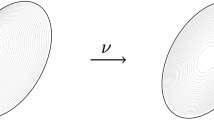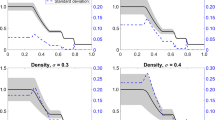Abstract
In this study, we present an implicit super-compact higher order scheme to solve the unsteady three-dimensional Navier–Stokes equations which is second-order accurate in time and fourth-order accurate in space. The stencil requires 19 points at the \(n\mathrm{th}\) time level and only seven points at the \((n+1)\mathrm{th}\) time level. The parabolic momentum equations are solved with a time-marching strategy and the pressure is obtained by a pressure-correction strategy based on a modified artificial compressibility approach. In the process, we also provide a Fourier stability analysis for the proposed scheme along with an analysis on its dispersion and diffusion characteristics. The scheme efficiently captures the solutions of both unsteady and steady-state Navier–Stokes equations: we first apply it to two problems having analytical solutions and then to the unsteady lid-driven cubic cavity problem. Our numerical results are excellent match with the analytical as well as established numerical results for the cavity.












Similar content being viewed by others
References
Abdallah S (1987) Numerical solutions for the incompressible Navier–Stokes equations in primitie variables using a non-staggered grid II. J Comput Phys 70:193–202
Albensoeder S, Kuhlmann HC (2005) Accurate three-dimensional lid-driven cavity flow. J Comput Phys 206(2):536–558
Anderson Jr JD (1995) Computational fluid dynamics. McGraw-Hill Inc., New York
Anderson DA, Tannehil JC, Pletcher RH (1984) Computational fluid mechanics and heat transfer. Hemisphere Publishing Corporation, New York
Cortes AB, Miller JD (1994) Numerical experiments with the lid driven cavity flow problem. Comput Fluids 23(8):1005–1027
Deville MO, Fischer PF, Mund EH (2002) High-order methods for incompressible fluid flow. Cambridge University Press, Cambridge
Erturk E, Gökcöl C (2006) Fourth order compact formulation of the Navier–Stokes equations and driven cavity flow at higher Reynolds numbers. Int J Numer Methods Fluids 50:421–436
Ethier CR, Steinman DA (1994) Exact fully 3D Navier–Stokes solutions for benchmarking. Int J Numer Methods Fluids 19:369–375
Fletcher CAJ (1983) Generating exact solutions of the two-dimensional Burgers’ equations. Int J Numer Methods Fluids 3(2):213–216
Ghia U, Ghia KN, Shin CT (1982) High-Re solutions for incompressible flow using the Navier–Stokes equation and a multigrid method. J Comput Phys 48:387–411
Gresho PM (1991) Some current cfd issues relevant to the incompressible Navier–Stokes equations. Comput Methods Appl Mech Eng 87:201–252
Guj G, Stella F (1993) A vorticity–velocity method for the numerical solution of 3D incompressible flows. J Comput Phys 106(2):286–298
Gupta MM, Monohar RM, Stephenson JH (1984) A single cell high order scheme for the convection–diffusion equation with variable coefficients. Int J Numer Methods Fluids 4:641–651
Gupta MM (1991) High accuracy solutions of incompressible Navier–Stokes equations. J Comput Phys 93:343–359
Gupta MM, Kouatchou J (1998) Symbolic derivation of finite difference approximation for three-dimensional Poisson equations. Numer Methods Partial Differ Equ 18(5):593–606
Gupta MM, Zhang J (2000) High accuracy multigrid solutions of the 3D convection–diffusion equations. Appl Math Comput 113(2–3):249–274
Gupta MM, Kalita JC (2005) A new paradigm for solving Navier–Stokes equations: streamfunction-velocity formulation. J Comput Phys 207(1):52–68
Jiang BN, Lin TN, Povinelli LA (1994) Large-scale computation of incompressible viscous flow by least-squares finite element method. Comput Methods Appl Mech Eng 114:213–231
Johnston H, Liu J-G (2002) A finite difference method for incompressible flow based on local pressure boundary conditions. J Comput Phys 180:120–154
Kalita JC, Dalal DC, Dass AK (2001) Fully compact higher order computation of steady state natural convection in a square cavity. Phys Rev E 64(6):066703 (1–13)
Kalita JC, Dalal DC, Dass AK (2002) A class of higher order compact schemes for the unsteady two-dimensional convection–diffusion equation with variable convection coefficients. Int J Numer Methods Fluids 38:1111–1131
Kalita JC, Dass AK, Dalal DC (2004) A transformation-free HOC for steady convection–diffusion on nonuniform grids. Int J Numer Methods Fluids 44:33–53
Kalita JC, Chhabra P (2006) An improved (9,5) higher order compact scheme for the transient two-dimensional convection–diffusion equations. Int J Numer Methods Fluids 51(7):703–717
Kalita JC, Sen S (2007) The (9,5) formulation for the transient Navier–Stokes equations in primitive variables. Int J Numer Methods Fluids 55(4):387–406
Kelley CT (1995) Iterative methods for linear and nonlinear equations. SIAM Publications, Philadelphia
Ku HC, Hirch RS, Taylor TD (1987) A pseudospectral method for solution of the three-dimensional incompressible Navier–Stokes equations. J Comput Phys 70:439–462
Lecointe Y, Piquet J (1984) On the use of several compact methods for the study of unsteady incompressible viscous flow round a circular cylinder. Comput Fluids 12(4):255–280
Lele SK (1992) Compact finite difference schemes with spectral-like resolution. J Comput Phys 103:16–42
Li M, Tang T, Fornberg B (1995) A compact fourth-order finite difference scheme for the steady incompressible Navier–Stokes equations. Int J Numer Methods Fluids 20(10):1137–1151
Mackinnon RJ, Johnson RW (1991) Differential equation based representation of truncation errors for accurate numerical solution. Int J Numer Methods Fluids 13:739–757
McTaggart N, Zagrski R, Bonnin X, Runov A, Schneider R (2004) Finite difference scheme for solving general 3D convection–diffusion equation. Comput Phys Commun 164(1–3):318–329
Meitz HL, Fasel HF (2000) A compact-difference scheme for the Navier–Stokes equations in vorticity–velocity formulation. J Comput Phys 157(1):371–403
Pereira JMC, Kobayashi MH, Pereira JCF (2001) A fourth-order-accurate finite volume compact method for the incompressible Navier–Stokes solutions. J Comput Phys 167(1):217–243
Peyret R (2002) Spectral methods for incompressible viscous flow. Applied Mathematical Science, vol. 148. Springer, New York
Rai MM, Moin P (1991) Direct simulation of turbulent flows using finite difference methods. J Comput Phys 96:15–53
Shankar PN, Deshpande MD (2000) Fluid mechanics in the driven cavity. Annu Rev Fluid Mech 32:93–136
Sheu T WH, Lin TN, Lin RK (2007) On the equal fourth-order accurate temporal/spartial scheme for the convection–diffusion equation. Numer Heat Transf Part B 51: 67–96
Shu C, Niu XD, Chew YT (2003) Taylor series expansion and least square based Lattice–Boltzmann method: three-dimensional formulation and its applications. Int J Mod Phys C 4(7):925–944
Spotz WF, Carey GF (1995) High-order compact scheme for the steady stream-function vorticity equations. Int J Numer Methods Eng 38:3497–3512
Spotz WF, Carey GF (1996) A high-order compact formulation for the 3D Poisson equation. Numer Methods Partial Differ Equ 12:235–243
Tafti D (1995) Alternate formulations for the pressure equation Laplacian on a collocated grid for solving unsteady incompressible Navier-Stokes equations. J Comput Phys 116:143–153
Weinan E, Liu JG (1996) Essentially compact schemes for unsteady viscous incompressible flows. J Comput Phys 126(1):122–138
Xu HY, Matovic MD, Pollard A (1997) Finite difference schemes for three-dimensional time-dependent convection–diffusion equation using full global discretization. J Comput Phys 130:109–122
Zhang J (1998) An explicit fourth order finite difference scheme for three dimensional convection-diffusion. Commun Numer Methods Eng 14:209–214
Zhang J (1998) Fast and high accuracy multigrid solution of the three dimensional Poisson equation. J Comput Phys 143:449–461
Zhang J, Lixin G, Kouatchou J (2000) A two colorable fourth-order compact difference scheme and parallel iterative solution for the 3D convection–diffusion equation. Math Comput Simul 54:65–80
Zhang J, Lixin G, Gupta MM (2000) Fourth order compact difference scheme for 3D convection–diffusion equation with boundary layers on nonuniform grids. Neural Parallel Sci Comput 18(3–4):373–392
Author information
Authors and Affiliations
Corresponding author
Additional information
Communicated by Abimael Loula.
Rights and permissions
About this article
Cite this article
Kalita, J.C. A super-compact higher order scheme for the unsteady 3D incompressible viscous flows. Comp. Appl. Math. 33, 717–738 (2014). https://doi.org/10.1007/s40314-013-0090-y
Received:
Revised:
Accepted:
Published:
Issue Date:
DOI: https://doi.org/10.1007/s40314-013-0090-y




